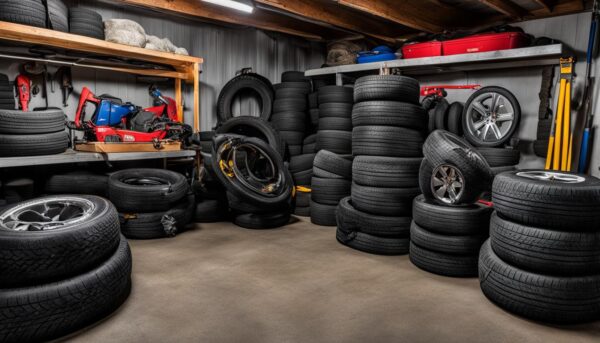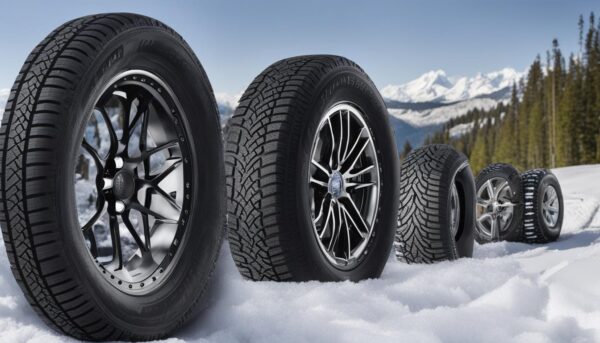Last Updated on 4 months
Maximize Your Budget with Smart Snow Tires Shopping
As winter approaches, many drivers face the challenge of finding affordable snow tires without compromising safety and performance. Thankfully, several budget-friendly winter tires are available if you know when and where to buy these tires and the right tire savings tips.
This guide will share valuable information on saving on snow tires and finding the best winter tire deals without sacrificing quality. From off-season sales to proper tire storage, we will provide helpful advice to help you make the most informed decision possible.
Key Takeaways
- Buying snow tires during off-season sales can lead to significant savings.
- Manufacturer rebates and online deals are available for cost-effective winter tire purchases.
- Proper off-season tire storage can extend the life of your tires.
- Investing in high-quality and long-lasting snow tires can save money in the long run.
- Understanding the benefits of snow tires for winter safety can help you make an intelligent purchasing decision.
Understanding the Value of Snow Tires for Winter Safety
When it comes to winter driving, snow tires play a crucial role in enhancing safety by providing better traction and braking in snowy and icy conditions. By understanding the snow tire benefits, drivers can make informed decisions that contribute to accident prevention while navigating slippery winter roads.
One of the most compelling arguments for snow tires is their superior icy road traction compared to all-season tires. Snow tires are specifically designed with a softer rubber compound and deeper tread patterns that increase traction on snow and ice. The unique characteristics of snow tires translate into shorter stopping distances and improved cornering capabilities. This is particularly important when driving in harsh winter conditions, where even a split-second difference can mean the difference between a safe stop and a collision.
“Using snow tires on all-wheel drive vehicles can lower accident risks by 5% and reduce severe injury or fatal accidents by 3%.”
The data demonstrates that snow tires offer a significant advantage in winter driving safety compared to all-season tires. While all-season tires claim to provide year-round performance, they often fall short in the most extreme winter weather, where dedicated snow tires shine.
| Snow Tires | All-Season Tires |
|---|---|
| Specifically designed for snow and ice | Designed for a wide range of conditions |
| Softer rubber compound | Harder rubber compound |
| Deeper tread patterns | Shallower tread patterns |
| Better traction and shorter stopping distances on snow and ice | Reduced traction and longer stopping distances in snow and icy conditions |
Considering the potential cost of accidents in vehicle repairs and possible injury, investing in snow tires for winter driving is a wise decision for enhanced safety and accident prevention. Ultimately, the key to winter tire safety lies in understanding their value and making the right choice for your specific driving needs.
The Best Time to Buy: Snatching Snow Tire Discounts
With winter tire rebate deadlines fast approaching, knowing the best time to buy snow tires is essential to take advantage of snow tire seasonal sales and manufacturer rebates. This section will guide you through shopping tips and strategies to help you find discount snow tires and save on your winter tire investment.
Seasonal Sales and Manufacturer Rebates
Typically, the months leading up to winter, such as October to December, offer the best opportunities for snow tire shopping. During this time, tire manufacturers and retailers may offer various tire promotions and rebates to entice customers, leading to significant savings on snow tires. Make a note of these winter tire rebate deadlines to ensure you don’t miss out on any potential discounts:
| Manufacturer | Rebate Deadline |
|---|---|
| Bridgestone | December 30 |
| Michelin | December 31 |
| Goodyear | December 31 |
| Cooper Tires | October 31 |
Where to Find the Best Snow Tire Deals
Finding the best deals on snow tires often requires some research online. Many online tire retailers sell snow tires at reduced prices compared to traditional tire dealers. Online purchases can eliminate intermediary costs; some retailers offer free shipping, reducing overall expenses.
As you navigate the world of winter tire discounts, consider these tips to find the best snow tire deals:
- Shop early in the season: Start searching for snow tires before the winter rush to maximize your chances of finding tire retailer promotions and affordable winter tires.
- Compare prices online: Use price comparison websites to find the best tire prices and deals from various retailers.
- Please take advantage of rebates: Check each manufacturer’s website for current rebates and apply for them before the deadline. Keep track of your receipts and invoices to ensure a smooth rebate process.
By applying these snow tire shopping tips and being aware of the best times to buy, you can snatch the best snow tire discounts and secure a safer driving experience throughout the winter.
Preserving Your Snow Tires for Extended Use
Extending the life of your snow tires saves you money in the long run and ensures that your winter driving experience remains safe and hassle-free. Proper storage and seasonal care are the keys to maintaining your winter tires and getting the most out of them. Simple tire preservation techniques can significantly prolong your snow tires’ life and maximize their performance.
Practicing seasonal tire care plays a vital role in preserving your winter tires. When swapping your snow tires for summer or all-season tires, it is time to ensure that your winter tires are clean and dry before you store them away. Inspecting your tires for noticeable wear or damage and addressing potential issues early on can also help maintain their effectiveness.
Did you know? Proper tire storage best practices can make a significant difference in maximizing tire longevity.
The optimal conditions for tire storage involve a dark, calm, and dry environment. A damp or humid area with fluctuating temperatures can trigger the development of rust, mold, or other damage that can negatively impact your snow tires’ efficiency. Consider investing in tire storage bags or racks to prevent detrimental external factors from affecting your tires.
To ensure proper tire preservation during storage, follow these best practices:
- Place each tire on its side or hang them vertically on a tire rack.
- Avoid placing the tires directly on a concrete floor. Instead, use a barrier such as a pallet or a plastic tarp to prevent direct contact.
- Rotate your tires every few months to help maintain tread evenness.
- Keep tires away from direct sunlight to reduce the risk of degradation due to ultraviolet exposure.
- Store tires at a distance from any electrical devices or heat sources.
In conclusion, with attention to detail and proper care, you can effectively prolong the life of your snow tires and enjoy a safer winter driving experience. Inspect your tires regularly for any signs of wear and practice best practices for tire storage to ensure optimal tire preservation.
Strategies for Storing Snow Tires Off-Season

Proper off-season care is essential to ensure the longevity of your snow tires, protecting them from potential damage and ensuring optimal performance during their subsequent use. This section will cover some vital snow tire storage tips, summer tire care, and off-season tire maintenance strategies to help you get the most out of your winter tires.
Keeping Your Tires in Top Shape During the Summer
When it comes to storing snow tires during the off-season, certain factors should be considered. Some practical ways to extend the life of your winter tires and protect their condition include:
- Avoiding direct sunlight exposure and excessive heat
- Keeping the tires away from electric and magnetic charges
- Maintaining the proper storage environment
- Inspecting and cleaning the tires before storing them
- Rotating the tires regularly during the off-season to distribute stress and wear evenly
One optimal tire storage technique is to place each tire in an opaque trash bag, sealing it tightly to restrict airflow. This method helps protect the snow tire from exposure to harmful elements such as ozone, moisture, and any chemicals that may be present in the storage area. Store the trash bag-wrapped tires in a cool, dark place, ideally away from furnaces, water pumps, or other heat-generating devices.
Proper storage techniques prevent damage from environmental factors and extend the usable life of the tire.
In addition to these snow tire upkeep tips, remember to watch your summer tire care. Conduct regular inspections of your vehicle’s tires throughout the season to spot potential issues such as punctures or uneven wear, and make any necessary repairs or replacements as needed. Adequate off-season tire maintenance for snow tires can result in a longer lifespan and better performance during winter months, ultimately saving you time and money.
Investing Wisely: Choosing Snow Tires with Longevity
When making an intelligent tire investment, selecting long-lasting snow tires that provide excellent performance and safety is crucial. Opting for high-quality winter tires with extended tread life warranties and fuel efficiency designs can save you money in the long run.
Several factors contribute to the durability of snow tires, including the rubber compound used in their construction and the thickness of the tread. Top-rated snow tires often feature advanced rubber compounds and thicker prints, resulting in longer-lasting use and better on-road performance during winter.
For a wise investment, select snow tires with long tread life warranties and those designed for fuel efficiency, which reduces heat and slows wear. Tires with higher mileage warranties often use better rubber compounds and thicker tread, leading to longer-lasting use and fewer replacements over time. – Expert Tip
| Important Factors | Why It Matters |
|---|---|
| Rubber Compound | Advanced rubber compounds in high-quality winter tires provide better grip, increased durability, and reduced wear. |
| Tread Thickness | Thicker treads offer improved traction and performance in snow, leading to a longer usable life for snow tires. |
| Mileage Warranty | Selecting tires with generous mileage warranties can protect your investment and minimize the frequency of tire replacements. |
| Fuel Efficiency | Choosing tires designed for fuel efficiency can reduce heat and wear, slowing down the wear-out process and prolonging tire life. |
Besides considering the mileage warranty, rubber compound, and tread thickness, comparing performance reviews from other drivers who have used these tires in extreme winter conditions is essential. This will help you make a more informed decision about which high-quality winter tires will be the best choice for your vehicle.
- Research various snow tire brands and models.
- Consider the rubber compound, tread thickness, and mileage warranty.
- Read reviews and testimonials from other drivers.
- Evaluate the overall cost, durability, and performance of each option.
- Choose the best snow tires based on your driving needs and budget.
In conclusion, investing wisely in durable snow tires with longevity ensures maximum safety, performance, and value for your money. It’s not just about buying the cheapest option; it’s about selecting the right tire to provide you with the best possible driving experience in winter conditions.
Snow Tire vs All-Season: Making the Smart Choice
Although all-season tires offer year-round performance, snow tires provide significantly better grip and safety in winter conditions. Despite their convenience, all-season tires on AWD vehicles or with chains cannot match the performance of dedicated snow tires on snowy or icy roads. This section will dive deeper into the winter tire comparison and highlight the all-season tire limitations to help you decide on optimal all-weather driving.
Dedicated snow tires are optimized for snow traction, while all-season tires are designed for a balance of performance and comfort throughout the year.
All-Season Tire Limitations
All-season tires might seem convenient because they are designed to provide decent performance in various driving conditions, including light snow. However, they come with certain limitations, particularly when it comes to heavy snow and icy roads:
- Less snow traction than dedicated snow tires
- Lower performance in freezing temperatures
- Not suitable for extreme winter conditions
Snow Tire Superiority
When comparing snow tires vs all-seasons, it is essential to consider the specific advantages that dedicated snow tires offer for winter driving:
- Better traction on snowy and icy roads
- Improved braking performance in winter conditions
- Enhanced handling and cornering abilities
| Feature | All-Season Tires | Snow Tires |
|---|---|---|
| Snow Traction | Moderate | Superior |
| Ice Traction | Low | High |
| Braking Performance | Adequate in mild conditions | Excellent in snow/ice |
| Handling | Good for all seasons | Optimized for winter |
Considering the benefits of snow tires and the limitations of all-season tires in winter conditions, it is wise to invest in dedicated tires for optimal safety and performance. Choosing between snow and tires vs. all-season tires based on your specific driving needs can ensure excellent safety and better vehicle performance in all-weather driving conditions.
DIY Tire Changing: How to Switch to Snow Tires at Home
Changing snow tires at home can save time and money, making it a practical skill for anyone with some know-how. This section will provide the essential tools and step-by-step instructions to help you switch smoothly and efficiently.
Tools You’ll Need to Change Your Tires
Before you begin, gather the necessary tire change equipment and materials for a successful DIY tire-changing experience:
- Valve stem core remover
- Pry bars
- Rubber hammer
- Soapy water or lubricant
- Jack
- Tire iron or lug wrench
- Air compressor
These winter tire tools will streamline the self-service tire swap process and make changing snow tires at home more manageable.
Step-by-Step Guide to Mounting Snow Tires
Follow these simple instructions to install your tires like a pro:
- Remove the wheels: Loosen the lug nuts with your tire iron, then jack up the vehicle and remove the lug nuts and wheels.
- Release air pressure: Use your valve stem core remover to remove the core and release air pressure from the tire.
- Break the tire bead: Position the wheel on its side and use a pry bar to break the bead by pressing down on the edge of the tire. Be careful not to damage the rim.
- Lubricate and pry the tire: Apply soapy water or lubricant to the edges and use the pry bars to remove the tire from the rim.
- Install the snow tire: Lubricate the edges of the snow tire and use the pry bars to mount it onto the rim, ensuring the tire bead is seated correctly.
- Set the bead with pressure: Use an air compressor to inflate the tire to the recommended pressure. This will help set the bead properly within the rim.
- Reinstall the wheel: Place the wheel back on your vehicle, tightening the lug nuts before lowering the jack.
- Finish tightening: Once the car is lowered, use your tire iron to tighten the lug nuts in a star pattern to ensure an even pressure distribution.
Following this guide will make mounting snow tires easy and efficient. For additional help, consider watching online video tutorials for visual guidance during installation.
Remember that practicing proper safety measures, such as using a jack stand to support your vehicle, can prevent accidents and ensure a successful tire change.
Cost Comparison: Studded Snow Tires Versus Regular Snow Tires

When it comes to snow tire investment, understanding the differences in performance and cost between studded and non-studded snow tires can help drivers make an informed decision.
Both studded and regular winter tires offer improved traction in snowy and icy conditions compared to all-season tires. However, choosing between studded and non-studded tires depends on regional laws, driving conditions, and tire pricing. This section delves into a snow tire price comparison to help drivers decide which option suits their needs.
These tires vs non-studded tires: your choice might depend on your budget and the driving conditions in your area.
Let’s explore the benefits and drawbacks of each type and perform a cost comparison that will aid you in making a more informed decision:
- Studded Snow Tires
These tires offer excellent traction on icy surfaces, thanks to small metal studs embedded in the tread. These studs grip the ice, giving drivers additional control and confidence during wintery drives. However, the main disadvantages of studded tires are the increased road noise, potential damage to road surfaces, and other restrictions compared to regular winter tires.
- Non-Studded Snow Tires
Non-studded or regular winter tires also offer enhanced traction in snow and icy conditions but lack the metal studs present in studded tires. Although their performance on ice may be slightly less superior than studded tires, their more affordable cost and wide acceptability often make them a more favorable option. Additionally, regular winter tires create less noise and are less likely to damage road surfaces.
| Tire Type | Average Cost Range per Tire | Benefits | Drawbacks |
|---|---|---|---|
| Studded Snow Tires | $100 to $300+ | Maximum ice traction, safer during severe winter weather | Higher cost, possible road restrictions, noise, potential road damage |
| Non-Studded Snow Tires | $60 to $250+ | Reasonable ice and snow performance, widely acceptable, less noise | Slightly less effective on ice than studded tires |
In conclusion, studded snow tires perform better on icy roads, but their additional cost and potential restrictions make them less ideal for some drivers. In contrast, non-studded or regular winter tires offer more affordable pricing while delivering solid snow and ice performance. Ultimately, the choice between studded and non-studded tires will depend on individual budgets, local weather conditions, and regional laws.
Where to Find Affordable Snow Tires for Sale
Finding affordable tires is essential for car owners looking to improve their winter driving safety without breaking the bank. Several options are available to help make the search more cost-effective while offering quality snow tires.
Shopping online is one of the best places to find snow tires at affordable prices. Online retailers often have lower overhead expenses than physical stores, allowing them to pass on the savings to customers. Additionally, they may offer regular promotions or free shipping deals that can further lower the overall cost of purchasing new snow tires.
2. End-of-Season Sales
Shopping during end-of-season sales is another excellent opportunity to find snow tires on sale. As winter comes to a close, retailers often discount their inventory of winter tires to make room for summer replacements. You can usually find great deals on quality snow tires for use the following winter by purchasing at the end of the season.
Pro Tip: Remember to store your snow tires properly during the off-season to extend their life and keep them in good condition.
3. Manufacturer Promotions
Keep an eye out for promotions offered by tire manufacturers. Companies like Michelin, Bridgestone, and Goodyear frequently offer mail-in rebates or instant savings on snow tire purchases. You can save significantly on your new winter tire set by taking advantage of these offers.
4. Local Tire Shops and Wholesale Clubs
While online shopping is a great way to find discounted winter tires, don’t forget to check your local tire shops and wholesale clubs for deals. Local businesses might have exclusive offers or overstock sales where you can find discounted snow tires that are still of good quality.
Where to Buy Winter Tires:
| Option | Pros | Cons |
|---|---|---|
| Online Retailers | Low overhead costs, regular promotions, and free shipping | May not have local support or installation services |
| End-of-Season Sales | Discounted inventory, the potential for high-quality options | Limited stock, may not find the exact tire model or size desired |
| Manufacturer Promotions | Rebates or instant savings, backed by tire companies | Promotions may be time-sensitive or have restrictions |
| Local Tire Shops and Wholesale Clubs | Personal customer service, local support, exclusive deals | Inventory may be limited; prices might not be the lowest |
In conclusion, affordable tires are obtainable through various channels, including online retailers, end-of-season sales, manufacturer promotions, or local tire shops. By exploring these options, you can equip your vehicle with high-quality snow tires while staying within your budget.
Maximize Your Snow Tire Savings
Investing in quality snow tires is essential for winter safety and optimal vehicle performance. Intelligent shopping strategies allow drivers to enjoy significant savings without compromising tire quality or functionality. This article’s winter tire shopping guide provides practical and economical advice for an informed and cost-effective buying process.
Ensure tire affordability by seeking seasonal sales, manufacturer rebates, and online deals. Proper tire storage and maintenance practices are equally essential to prolong the lifespan of your snow tires. Invest in snow tires with extended tread life warranties when purchasing, as this signifies higher-quality rubber compounds and more durable tires.
Lastly, learning the basics of DIY tire installation can lead to additional savings while honing practical skills that can be applied in other vehicle maintenance areas. In conclusion, understanding the importance of snow tires for winter safety and employing effective tire-buying methods allows drivers to secure the best deals and navigate the harsh winter months with confidence and ease.
FAQs
What are some strategies to save money on snow tires?
To save money on snow tires, consider buying during off-season sales, using manufacturer rebates, and finding deals online. Proper tire storage and investing in high-quality, long-lasting snow tires can also contribute to cost savings in the long run.
How do snow tires improve winter driving safety?
Snow tires provide better traction and braking in snow and icy conditions, improving overall vehicle handling and lowering the risk of accidents during the winter months. Studies have shown that using snow tires on all-wheel drive vehicles can lower accident risks by 5% and reduce severe injury or fatal accidents by 3%.
When is the best time to buy snow tires for the best deals?
The best time to buy snow tires is during seasonal sales and when manufacturer rebates are available. Promotions often occur before winter, such as October to December, allowing you to purchase snow tires at a lower price before expiration.
How should I store my snow tires during the off-season?
Proper storage is essential for extending the life of your snow tires. Store them in a dark, cool area away from direct sunlight and electric sources. Consider using an opaque trash bag for each tire and avoid placing them near furnaces or water pumps.
Should I choose snow tires or all-season tires for winter driving?
Although all-season tires offer year-round performance, snow tires provide significantly better grip and safety in winter conditions. Despite their convenience, all-season tires on AWD vehicles or with chains cannot match the performance of dedicated snow tires on snowy or icy roads.
What tools do I need to change snow tires at home?
To change snow tires at home, you’ll need a valve stem core remover, pry bars, a rubber hammer, soapy water or lubricant, a jack, a tire iron, and an air compressor. Having the right tools can make the DIY process smoother and more manageable.
What is the price difference between studded and regular snow tires?
The price difference between studded and regular snow tires can vary. Studded tires may offer enhanced traction but come with additional costs and potential road limitations. Frequent, non-studded tires are generally more affordable and widely acceptable.
Where can I find affordable snow tires for sale?
Affordable snow tires can be found at online retailers, during the tire off-season, and through promotions offered by manufacturers. These deals can help reduce overall costs without sacrificing quality or safety.
Source Links









